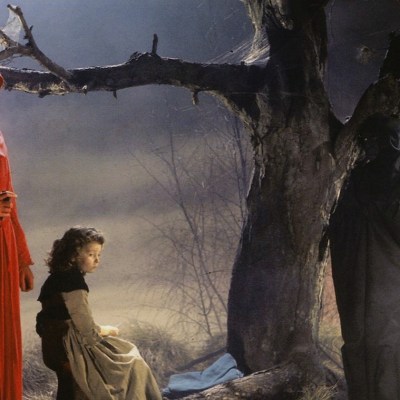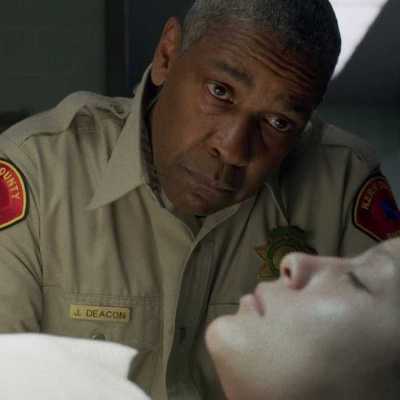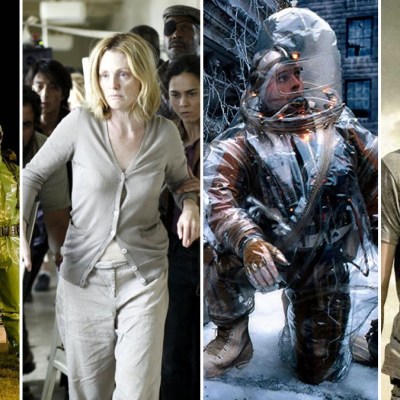10 remarkable things about The Swarm
Michael Caine described it as one of his worst films. But that doesn't mean that there aren't some remarkable things about The Swarm...
Director and producer Irwin Allen didn’t invent the disaster movie, but he certainly helped define it. The Poseidon Adventure (1972) and The Towering Inferno (1974) established a template of Hollywood glamour, melodrama and mass destruction, with some of the most famous actors of the era meeting their maker in spectacular fashion.
Even though Allen didn’t direct all of The Poseidon Adventure (he only handled the disaster scenes, while Ronald Neame dealt with the talky bits), Allen’s larger-than-life personality, elaborately woven hair and reputation as a producer soon established him as cinema’s “master of disaster” – and the results were both critically and financial smashes.
Then along came 1978’s The Swarm, and Allen’s fortunes took a bit of a nose-dive. Where The Poseidon Adventure and The Towering Inferno made fortunes, The Swarm lost money, taking less than half of its $21m budget. Its starry cast, featuring Michael Caine, Richard Chamberlaine and Olivia de Havilland, wailed ranted their way through a frankly bonkers script, and the result was a critically-panned mess.
So what went so bizarrely wrong with The Swarm? Let’s have a watch and find out – and see if we can’t find a few remarkable things to highlight about it in the process…
1. The opening’s surprisingly effective
With its less than sterling reputation, you might think that The Swarm would be utterly inept from beginning to end. Instead, it opens with a slow and quite classy introductory scene, in which anonymous soldiers clad in protective suits and helmets explore an apparently deserted military base.
Jerry Goldsmith’s score prowls effectively – there are echoes of the genius he’d bring to Ridley Scott’s Alien the following year – and there’s a serious tone to the direction that recalls Robert Wise’s cerebral sci-fi drama, The Andromeda Strain. As the soldiers explore the various levels of this subterranean base, they discover a control room full of bodies – cause of death: unknown. What mysterious force could possibly break into a high-security military base, kill all its occupants, then escape without leaving a trace?
Unfortunately, this air of intrigue evaporates as soon as the dialogue kicks in. The ranting, pathologically suspicious General Slater (Academy Award nominee Richard Widmark) is convinced that the base has been subjected to some form of chemical attack, and demands to know why a beige civilian van’s parked outside. The owner of that van, he thinks, may be the culprit behind this senseless crime.
And then the subject of the next entry shows up, and all bets are off.
2. Michael Caine
Across a long and varied career, Sir Michael Caine has turned in some great performances, with no fewer than six Oscar nominations to his name. The Swarm isn’t a movie that comes up in the same breath as his award-winning movies very often, but nevertheless, Caine’s performance here is a veritable tornado of shouting, pointing and brown turtleneck sweaters.
In fact, Caine’s character, Doctor Bradford Crane, is a bit of an enigma throughout. Just as the soldiers in the military base have taken off their helmets and concluded that everyone’s dead, a pair of lift doors open, and out steps Dr Crane – the only survivor, and utterly unharmed.
“Who the hell are you?” a soldier quite reasonably asks of this mysterious figure. And it has to be said that, even when it’s established that Dr Crane is the film’s hero, he remains a distant and even slightly frightening presence throughout.
Dr Crane explains that he’s an entomologist, who was following a cloud of killer bees in his van when he saw them descend on the army base. At first, General Slater laughs off the notion of a swarm of bees taking out a military base, before a series of reports come in that back up Dr Crane’s story.
Even so, Dr Crane and General Slater remain at loggerheads throughout the rest of the film, with entire scenes devoted to the pair screaming into each other’s faces until one of them relents – it’s like watching an arm wrestling match, except with shouting and pages of dialogue. Caine gives an extraordinarily desperate performance in these moments, as though he’s acting as hard as he can to save his very soul.
Or Maybe he’s just channelling the discomfort of wearing that restrictive turtleneck sweater into his acting.
Really, we never learn very much about Dr Crane other than that he loves the colour brown, eats sunflower seeds, was orphaned as a child following a house fire, and that his voice drops from a shriek to a seductive baritone when in the presence of a comely female doctor.
(“I’ve got cardio-pep compound in my bag” he says suggestively to Dr Anderson (Katharine Ross), the sly old devil.)
General Slater rarely puts aside his theory that Dr Crane might secretly be the maniac behind the bee invasion, and for much of the film, it’s difficult not to share that theory. After all, Dr Crane does have some slightly mad notions of his own, like his idea that a war between humans and insects has been steadily brewing.
“We’ve been fighting a losing battle against the insects for 15 years,” Dr Crane insists. “But I never thought I’d see the final face-off in my lifetime. And I never thought it would be the bees. They’ve always been our friends!”
3. There are lots of helicopters
Irwin Allen managed to secure the assistance of the US Air Force in the making of The Swarm, and he makes full use of their services – to the point where helicopters feature in almost every other scene. The film begins with General Slater coming in on a helicopter.
It ends with Dr Crane riding around in a helicopter. And one of the most memorable and hilarious scenes in The Swarm involves helicopters.
Between one of Dr Crane and General Slater’s early shouting matches, a military helicopter pilot radios the base to say he’s made contact with an ominous cloud of bees flying away from the facility at a steady seven miles per hour. The pilot takes his helicopter closer to the swarm, only for them to strike his craft like deadly, buzzing Sugar Puffs. What follows is pure cinematic brilliance.
Pilot: Oh my God! Bees, bees, millions of bees! Air Search 28 to base – millions of bees!
General Slater: Bees?
Pilot: Yes. They’re all around me now, all over the canopy, trying to get in!
General Slater: Well, get above them, man! Take it up!
Pilot: Wah, I can’t sir! I’m losing power. Oh my God!
[The helicopter crashes]
General Slater: Good Lord.
4. A picnic is ruined
Confession time: when your humble writer first saw The Swarm at the age of about five or six, this particular scene seemed utterly terrifying. Having allowed us to digest all the drama at the air base, the film cuts to an ordinary family arriving in a remote bit of parkland for a picnic. But as the gingham cloth’s laid down and the sandwiches are distributed, the killer bees emerge from a nearby tree and attack. A young boy named Paul manages to find safety in his parents’ station wagon, and can only watch helplessly as the bees descend on his mother and father.
Even now, there’s a nightmarish edge to the scene – though its flaws are also readily apparent when viewed through grown-up eyes. For one thing, the actors who play Paul’s parents are like robots. “I am hungry,” the father says, with all the humanity of a Dalek. “Paul, would you go to the car and fetch the Thermos?” the mother asks, both looking and sounding like an escaped project from The Stepford Wives.
It’s also fair to say that Irwin Allen makes some unfortunate editorial decisions in this sequence. A close-up of a bee sitting on a leaf – no doubt plotting he and his friends’ mischief on the innocent picnickers – is an unintentionally amusing bit of foreshadowing.
(You could even say it ruins our suspension of ‘dis-bee-leaf’. You could, but we wouldn’t.)
And then we cut to a bee’s eye view of the scene, which is strikingly like a famous POV shot from the original version of The Fly:
The bees aren’t just murderers – they’re incurable voyeurs, too.
5. The number of characters is slightly bewildering
Like an awful lot of 70s disaster movies, The Swarm introduces so many characters that it’s probably best to give up trying to remember who they all are and what they do for a living, and start thinking of them by the actors’ names instead. Henry Fonda rolls around in a wheelchair as a scientist with the wonderful name Dr Walter Krim, and at one point says, “Hmm. Smells like bananas”.
Slim Pickens has a thankless cameo role as a grieving father, who turns up at the base, collects his son’s body and promptly disappears from the movie for good. Oscar-winning actress Olivia de Havilland is one of several actors who are introduced, given a bit of story to deal with, and is then abruptly killed.
That Irwin Allen even managed to get such an amazing cast together for a film where the requirements are to run away from bees and then die horribly is a testament to his clout as a filmmaker at the time – and it has to be said that not all the stars look best pleased at appearing in front of the camera.
When a very grumpy-looking Richard Chamberlain shows up (in a helicopter, of course) and says, “I think you should know I came here reluctantly,” we can safely assume he’s talking about agreeing to star in the film itself.
6. Victims see giant bees
A scientist later concludes that it takes a mere three stings from these ‘Africanised’ killer bees to kill a human being. Fewer than that, and the victim goes into a sweaty fever, where he or she begins to see giant bees looming up in front of them. In one fantastic scene, a delirious female victim opens a bedroom door, sees a giant bee behind it, screams, and then collapses in a heap.
Theoretically, this should look quite scary, especially when the image is projected on a gigantic cinema screen. But in practice, the bees end up looking quite cute and cuddly – which is probably the opposite of what Irwin Allen was hoping for.
7. Three young boys hide in dustbins
If you edited out all the adults arguing, you’d be left with the story of a small boy who’s having the worst day of his young life. Having survived the slaughter of his parents, Paul drives off in their car, then promptly crashes it into an elaborate flower arrangement sitting on the street of a neighbouring small town called Maryville.
Coming out of his giant-bee-fever, Paul sets off with two friends and some petrol bombs, determined to exact his revenge on the insects that ruined his childhood. Unfortunately, it all goes a bit wrong, and the bees mount a counter attack. Realising their error, the boys hide beneath three empty, incredibly clean metal bins left in a row in the middle of a field.
8. The script is a strange work of art
At 156 minutes, The Swarm is a punishingly long film. But what makes the film so relentlessly entertaining – aside from a shouting Michael Caine and his ever-changing range of brown outfits – is the bewildering genius of its script. Not one character in this movie speaks like a normal human being – instead, they blurt out snippets of information apropos of nothing, or make weird and unexpected statements.
There are far too many bizarre lines to list here, but for brevity’s sake, here are a few of our favourites:
[A news reporter on a radio] “Elsewhere in the country, people mostly stayed indoors or went to church. But between their prayers, they watched the weather.”
“When that swarm discovers that some of their number have been taken captive, they might come back to Maryville.”
“My God, Brad, what good is all that science?”
“What these bees did here, they could do again. Just like they knocked your two choppers down.”
“While you’re about it, could I have my leather pouch, please? The one with the sunflower seeds in it.”
Then there’s General Slater, who emphasises his utterances so oddly that they begin to sound like puns:
“I always credit my enemy with intelligence, no matter what he may bee”
“Crane, either you’re some crackpot, or there’s a direct tie-up between what’s happened in this complex, and your bee-ing in it.”
9. It’s all quite harsh
All these moments of chortle-inducing levity are quite important, because even with them, The Swarm‘s still full of scenes nasty enough to give even jaded viewers a moment’s pause. There are regular shots of children being stung to death – including one quite horrible shot of a young boy’s lifeless body lying on the ground, which would look even more haunting if he wasn’t clutching a gigantic lollipop in his hand.
An attempt to rush dozens of innocent people from Maryville goes awry when the train carrying the evacuees derails and plummets from a mountain. Oh, and remember the young Paul from earlier on? Not only did his antics with petrol bombs result in the bees attacking Maryville, with terrible loss of life, but he eventually ends up in hospital, where dies. We told you he was having a bad day.
As it turns out, things were just as harsh behind the scenes. In those pre-CG days, real bees had to be used in certain scenes, so rather drastic steps had to be made to keep the cast of rich Hollywood types from being stung too much. To this end, an army of handlers had an estimated 800,000 bees incapacitated in freezers, before their stingers were snipped off with clippers.
If that sounds cruel, the bees did at least manage to get their own back to a certain degree. Legend has it that the cast and crew would often find little yellow dots on their clothing, which Michael Caine assumed was honey, and often ate. It’s quite likely this yellow substance wasn’t honey, but faeces.
10. Both director and star distanced themselves from the film
We’ve now made it through more than two hours of death, disaster and ill-advised schemes. Said schemes include Henry Fonda’s deciding to poison himself and then describe the experience until the point of death, and someone else has a plan that involves saving America by setting fire to it with flamethrowers. But finally, Dr Crane has a cunning idea that, in the parlance of every disaster flick ever made, “might… just… work”.
Realising that the bees were attracted to the air base because they thought its sonic alarm was a mating call, Dr Crane lures the swarm out to sea with ghetto blasters strapped to rubber dinghies, then has the honey-making murderers blown up with a missile strike. Really, we’re surprised that no one thought of having the bees defeated by having Michael Caine shout them to death.
And thus, Mother Nature, that terrifying force of evil, is soundly defeated.
In the wake of The Swarm‘s release, and its subsequent critical drubbing, quite a few people decided to distance themselves from it. Irwin Allen refused to talk publically about it, while Michael Caine has stated that it’s among the worst films he’s ever appeared in – and to be fair, he’s made quite a few, such as the magnificently awful Jaws: The Revenge.
As ever, Caine could take comfort in three things. One, its pay cheque went to a good cause (“I made The Swarm because my mother needed a house to live in”, he told The Sabotage Times this year). Two, that his performance is the life and soul of this overblown film. And three, and that The Swarm wasn’t the only gloriously terrible killer bee movie released that very same year…


